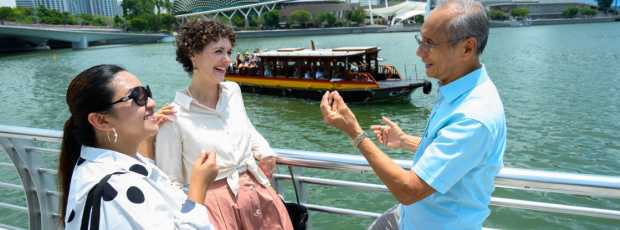Table Of Contents
- My Year-Round Love Affair with the Lion City
- Understanding Singapore's Tropical Climate Year Round
- December to February: Peak Season Magic
- March to May: Singapore's Hidden Gem Season
- June to August: Heat, Events, and High Energy
- September to November: Monsoon Season Returns
- How Weather Impacts Popular Attractions
- My Secret Times for Fewer Crowds
- Travel Costs Throughout the Year
- Festivals That Define Our Calendar
- When Is the Best Time to Visit Singapore?
[HERO IMAGE: Overhead view of Singapore skyline with Marina Bay Sands in the distance during golden hour. Filename: singapore-skyline-goldenhour.jpg]
My Year-Round Love Affair with the Lion City
I've called Singapore home for over two decades, and the question I hear most from visitors is simple: "When is the best time to visit Singapore?" The answer, I've learned, isn't straightforward. This island nation pulses with different energy throughout the year, each season bringing its own gifts and challenges.
Growing up here, I thought everyone knew Singapore was a year round destination, that our tropical climate meant consistent warmth and humidity regardless of the calendar. But through countless conversations with travelers, I've discovered that timing can transform your experience entirely. The best time to visit Singapore depends on what you're seeking: fewer crowds, cultural celebrations, or the most comfortable weather conditions.
Understanding Singapore's Tropical Climate Year Round
The Two Monsoon Seasons
Singapore's tropical climate brings average temperatures between 25°C and 31°C throughout the year. As a city state positioned just north of the equator, we experience minimal seasonal variation compared to temperate countries.
The northeast monsoons arrive between December and March, bringing cooler temperatures and occasional heavy rain. During my morning walks along the Singapore River, I notice how the air carries a different quality, cleaner, somehow lighter.
When Heat Peaks
Between June and September, the southwest monsoon creates our warmest months. Temperatures can feel particularly intense during midday, especially along busy streets like Orchard Road. I've learned to appreciate how locals adapt: longer lunches in air-conditioned shopping malls and later dinner hours.
The transitional months, April, May, October, and November, often bring the most unpredictable weather. Short, intense afternoon thunderstorms can clear the air beautifully, though they sometimes disrupt outdoor plans.
Looking for a private city experience in Singapore?
Explore the city with a local who plans a private day just for you; no groups, no scripts.
December to February: Peak Season Magic
Chinese New Year Transforms Everything
December through February represents the best time to visit Singapore for many travelers. The northeast monsoon brings cooler, drier weather that makes exploring on foot more comfortable. Average temperatures hover around 26°C, and humidity levels feel more manageable than other times of year.
Chinese New Year transforms the city completely. Walking through Chinatown during this period, I'm struck by how the familiar streets become stages for celebration. Red lanterns cast warm light over evening crowds, and the scent of traditional foods fills the air.
Holiday Atmosphere and School Breaks
December brings Christmas lights throughout the city, creating a unique tropical holiday atmosphere. Universal Studios Singapore decorates elaborately during this period, and families often choose this time for their Singapore experiences because of school holidays in many countries.
February offers perhaps the most comfortable weather conditions of the year. I often recommend this month to friends planning their first visit Singapore trip. The post-Chinese New Year period brings fewer crowds but maintains pleasant weather, making it ideal for exploring the Singapore Zoo or Marina Bay.
March to May: Singapore's Hidden Gem Season
When the Orchids Bloom Best
March marks the beginning of what I consider Singapore's most underrated travel period. As the northeast monsoons fade, we enter a transitional season with occasional rainfall but generally pleasant temperatures. The Orchid Garden showcases its most spectacular blooms during these months, and I find myself drawn to the Singapore Botanic Gardens more frequently.
Perfect Weather, Fewer Tourists
April and May offer some of the year's most beautiful weather, yet many travelers overlook this time to visit Singapore. International visitor numbers remain lower than peak season, which means shorter queues at popular attractions and more intimate experiences at local food stalls.
The Singapore Flyer provides particularly stunning views during April evenings. Without the haze that sometimes accompanies our warmer months, the city spreads out clearly in all directions. Cultural events during this period tend to be smaller, more intimate affairs rather than the grand spectacles of Chinese New Year.
June to August: Heat, Events, and High Energy
National Day Celebrations
June ushers in our warmest period, but also our most energetic. Singapore's National Day in August represents the pinnacle of our cultural celebrations, with rehearsals and preparations creating anticipation throughout these months. The city buzzes with patriotic fervor that even cynical locals find hard to resist.
July and August are undeniably hot—these are our warmest months, with temperatures regularly reaching 32°C and humidity that can feel overwhelming for visitors from cooler climates.
Shopping Season and Food Festivals
The Great Singapore Sale transforms Orchard Road into a shopper's paradise from June through August. Shopping malls extend their hours, and the atmosphere feels celebratory rather than merely commercial. Hotel prices rise during this high season, but the abundance of cultural events can justify the expense.
The Singapore Food Festival typically occurs in July, celebrating our incredible culinary diversity. This event showcases both hawker food traditions and innovative contemporary cuisine. Indoor attractions become particularly valuable during these months, with Universal Studios Singapore offering air-conditioned relief.
What if your day in Singapore was planned by someone who knows it — and you?
City Unscripted matches you with a local host who creates a private experience based on your interests, not a set route.
September to November: Monsoon Season Returns
Cultural Celebrations Light Up the City
September signals the return of the southwest monsoon, bringing afternoon thunderstorms that clear the air and cool the city. I've always found these months deeply atmospheric—the way rain transforms Singapore's streets, creating momentary rivers and revealing the island nation's tropical nature.
October and November showcase some of our most beautiful cultural celebrations. Deepavali illuminates Little India with thousands of lights, creating scenes that rival any holiday display I've witnessed elsewhere.
Traditional Festivals and Spiritual Observances
The Hungry Ghost Festival during this period offers insights into Singapore's Chinese traditions that many visitors never experience. There are also Hari Raya Aidilfitri celebrations, which happen depending on the lunar calendar. Weather conditions during these months can be unpredictable—long periods of sunshine interrupted by intense afternoon storms.
How Weather Impacts Popular Attractions
Marina Bay and Infinity Pools
Weather patterns significantly influence how you'll experience Singapore's most famous attractions. Marina Bay Sands' infinity pool becomes less appealing during overcast days, though the views remain spectacular. I've noticed that cloudy conditions actually enhance photography, reducing harsh shadows.
Outdoor vs Indoor Attractions
The Singapore Zoo adapts beautifully to our tropical climate. During the warmest months, many animals become more active in the early morning and late afternoon. Rain doesn't diminish the experience, covered walkways and indoor exhibits ensure comfortable exploration.
Sentosa Island offers numerous indoor attractions that provide relief during hot or rainy weather. Universal Studios maintains its appeal all year, though outdoor rides may temporarily close during thunderstorms.
Marina Bay transforms throughout the year. During cooler months, evening walks along the waterfront feel pleasant and invigorating. In July and August, the area comes alive after sunset when temperatures become more comfortable.
My Secret Times for Fewer Crowds
Early Morning Magic
After years of observing tourist patterns, I've identified several periods when Singapore reveals its more intimate character. Weekday mornings in March and April offer particularly peaceful experiences. Popular attractions have fewer crowds, and you can explore at a more contemplative pace.
Post-Festival Tranquility
The period immediately after Chinese New Year brings unique opportunities. While still technically high season, many tourists have departed, leaving locals to slowly resume normal routines. This transitional time offers glimpses of authentic daily life rarely visible during peak periods.
Early morning hours throughout the year provide magical experiences that most visitors miss. Kampong Glam before 8 AM feels like a different neighborhood entirely—quiet, atmospheric, perfect for discovering the hidden gems in Singapore that reveal themselves during quieter periods.
May represents my favorite month for experiencing Singapore's outdoor spaces. The weather remains comfortable, school holidays haven't begun, and the city feels more relaxed.
Tip
We match you with the right host, not just any guide.Want to experience the real Singapore with someone who lives there?
A fully private experience, planned and led by a local host who tailors the day to you
Travel Costs Throughout the Year
Peak Season Premium Pricing
Understanding seasonal pricing patterns can significantly impact your travel budget. Hotel prices reach their peak during December and January, particularly around Chinese New Year. Booking during this high season often means paying 40-60% more than off-peak rates.
Best Value Months
March through May offers the best value for accommodation. Hotel prices drop significantly after Chinese New Year, and you'll often find promotional rates that make luxury properties more accessible. The weather remains pleasant, making this period ideal for budget-conscious travelers.
Food costs remain relatively stable year round, though hawker food stalls may adjust prices slightly during peak tourist seasons. Shopping offers the best deals during the Great Singapore Sale, though savings may be offset by higher accommodation costs.
September through November presents interesting opportunities for value-conscious travelers. While weather can be unpredictable, hotel prices remain reasonable, and cultural events provide rich experiences without premium pricing.
Festivals That Define Our Calendar
Major Celebrations and Quiet Observances
Singapore's cultural calendar creates distinct periods that define when to visit Singapore based on your interests. Each major festival transforms different neighborhoods, offering unique windows into our multicultural heritage.
Chinese New Year remains our most significant celebration, but smaller festivals often provide more authentic cultural experiences.
The Esplanade hosts numerous cultural events throughout the year, many timed to coincide with traditional festivals. Outdoor performances during cooler months create particularly memorable experiences, when evening breezes carry music across Marina Bay.
Buddhist, Hindu, and Muslim festivals follow lunar calendars, creating varying annual schedules that add richness to Singapore's cultural landscape.
When Is the Best Time to Visit Singapore?
It Depends on Your Travel Style
After reflecting on decades of life in this city, I believe the best time to visit Singapore ultimately depends on your priorities and temperament. If you thrive in festive atmospheres and don't mind crowds or higher costs, December through February offers unparalleled energy and celebration.
For those seeking comfortable weather and reasonable prices, March through May provides an ideal balance. You'll experience pleasant temperatures, fewer crowds, and the opportunity to explore Singapore at a more relaxed pace.
Every Season Has Its Magic
The warmest months, June through August, reward visitors with incredible cultural events and the full intensity of tropical Singapore. The weather can be challenging, but this is when our city truly sparkles with energy and celebration.
Singapore remains an all year destination because each season offers distinct pleasures and insights. Rather than seeking the single best time to visit, consider what aspects of our city most appeal to your imagination. The Lion City will welcome you regardless of when you arrive, ready to share its stories in whatever weather conditions the sky provides.
Ready to plan your perfect day in Singapore?
Start your experienceWhat if your day in Singapore was planned by someone who knows it — and you?
City Unscripted matches you with a local host who creates a private experience based on your interests, not a set route.
Want to experience the real Singapore with someone who lives there?
A fully private experience, planned and led by a local host who tailors the day to you











